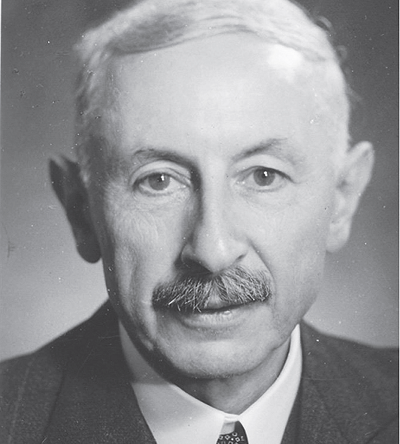Paul Karrer, a Swiss organic chemist, was the first to unravel the chemical structure of several vitamins and plant dyes, and also the first to synthesise Vitamin A (retinol, in 1931) Vitamin B2 (riboflavin, in 1935), Vitamin E (tocopherol, in 1938), and Vitamin K (phytonadione, in 1939). In 1937, he was awarded the Nobel Prize in chemistry “for his research into the constitution of carotenoids, flavins, and vitamins A and B”. Karrer shared the prize with British chemist Sir Walter Norman Haworth who won it for his research on the structural formula of carbohydrates and vitamin C.
A lifetime dedicated to scientific research
Paul Karrer was born in Moscow on April 21, 1889, but his parents were from Switzerland. His father worked as a dentist in Russia. When Karrer was just three years old, his family moved back to their home country, staying for a short while in Zurich before settling in Aarau, a pretty town at the foot of the Jura Mountains, near Zurich.
Karrer developed an interest in science while in secondary school. He received his Ph.D. in 1911 from the University of Zurich for his thesis on cobalt complexes. He then worked for one year as an assistant to his Ph.D. professor, Alfred Werner – the well-known Nobel Prize winner in Chemistry and the ‘Father’ of Coordination Chemistry – at the Chemical Institute of the University of Zurich. Following this, he worked under Paul Ehrlich, a Nobel prize winner in Physiology or Medicine, in the chemistry section of the Georg Speyer Haus in Frankfurt, Germany. Ehrlich had invented the precursor technique to Gram staining of bacteria for diagnosing diseases, and also discovered Salvarsan, the ‘magic bullet’ against syphilis. For five and a half years, Karrer worked there, studying the organic compounds of arsenic and other metals such as antimony and bismuth.
After World War I broke out, Karrer was called back to Switzerland to serve as an artillery officer in the Swiss army. Then, in 1915, after Ehrlich passed away, he returned to Frankfurt to take up Ehrlich’s position as director of chemical research at the Research Institute for Chemotherapy. In 1919, he succeeded Werner as professor of chemistry at the University of Zurich and Director of the Chemical Institute in Zurich. All his milestones in research were achieved at this institute. In the 1920s, he focused mainly on plant pigments and natural products. In the 1930s, he figured out the structures of carotene and lycopene, something that had puzzled scientists for years. In 1942, his research led to a better understanding of the structure and function of nicotine-amide-adenine dinucleotide (NAD), a coenzyme essential for the transfer of electrons in the energy system of the cell. In 1950, he completed his work on the total synthesis of carotenoids. He remained at the institute in Zurich till his retirement in 1959.
From colourful flowers to carrots
Throughout his life, plant pigments attracted Karrer. And hence, from colourful flowers to carrots, natural specimens such as these were permanent fixtures in his laboratory. He was especially successful with carotenoids – chemical compounds that impart the characteristic yellow, orange, or red colour to fruits and vegetables such as tomatoes, carrots, capsicum, and saffron. Engaging in meticulous chemical analysis, Karrer succeeded in finding out the structural formula for these. Not just that, he also identified a useful link to the formation of Vitamin A in the human body. He discovered how the animal body uses beta-carotene to produce Vitamin A, the vitamin important for proper vision and the lack of which causes night blindness. In 1930, when he established the correct structural formula for beta-carotene, it was a pioneering work, for it was the first time that anyone had discovered the structure of a provitamin (vitamin precursor) or vitamin.
Perhaps, Karrer’s most important scientific contribution was proving that vitamin A is structurally related to carotenoids. He then went on to establish the constitution of Vitamin A, and followed this up by confirming the structure Albert von Szent-Gyorgyi had ascribed to Vitamin C, and venturing into researches on Vitamin B2 and Vitamin E. While studying the chemistry of the flavins, he discovered that lactoflavin was a part of the complex structure earlier thought to be Vitamin B2. As mentioned earlier, he proceeded to successfully synthesise Vitamin B2, Vitamin E, and Vitamin K.
Paul Karrer’s most famous publication, Lehrbuch der Organischen Chemie (A text book of Organic Chemistry) went on to have 14 editions published and was translated into seven languages. He also set up two major foundations for the advancement of science, namely, the Fritz Hoffmann-La Roche Foundation for the advancement of interdisciplinary study groups in Switzerland, and the Foundation of Scholarships in Chemistry. Karrer also published an astonishingly large number of scientific papers – over 1,000 of them – in various fields including organic chemistry, especially related to vitamins, co-enzymes, plant pigments, curare and other alkaloids, carbohydrates, amino acids, and organo-arsenic compounds.
Recognitions
Karrer was appointed as the President of the 14th International Congress on Pure and Applied Chemistry held in Zurich in 1955. He received honorary doctorate degrees from a number of universities in Europe and America. He was a member of numerous chemical and biochemical societies worldwide including the Academie des Sciences (Paris); the Royal Society (London); National Academy of Science (Washington); Royal Academy of Sciences (Stockholm); the National Academy (Rome); Royal Academy of Belgium; the Royal Netherlands Academy of Sciences; and the Indian Academy of Science. Apart from the prestigious Nobel Prize, he also won the Marcel Benoist Prize and the Cannizzaro prize, both of which are esteemed awards in the field of Chemistry. In 1995, he was honoured on a stamp issued by the government of Guyana.
A group of reputed companies including CIBA AG, J. R. Geigy, F. Hoffman la Roche & Co. AG, Sandoz AG, Societe des Produits Nestle AG, and Dr. A. Wander AG, established the highly respected Paul Karrer Gold Medal in his honour in 1959 on the occasion of the public celebration of his 70th birthday at the auditorium of the University of Zurich. They did this following suggestions made by friends and former students of Paul Karrer who were keen that he should be honoured in a befitting way for his many significant contributions to the development of chemistry. The medal is awarded annually or biannually to an outstanding researcher in the field of chemistry who then delivers a lecture at the University of Zurich. The recipients to date include several Nobel Prize winners in Chemistry and Medicine. The front of the Medal has a relief of the left-side profile of Paul Karrer. The back is engraved with the words University of Zurich – Paul Karrer Lecture.
After completing his Ph.D. at the University of Zurich under Nobel laureate Alfred Werner, Karrer then continued to teach and research for 40 years at the same institution. Throughout his life, he never drove a car. Neither did he consider leaving the University of Zurich, despite receiving several good offers from various universities across the world.
Following a brief illness, Paul Karrer died in Zurich at the age of 82 on June 18, 1971. He was buried at Fluntern Cemetery, Zurich, the same cemetery where the acclaimed Irish novelist James Joyce, Croatian scientist and winner of the 1939 Nobel Prize in Chemistry – Leopold Ruzicka, and the famed Swiss physicist Paul Scherrer is interred.
References
1. Nobelprize.org: Paul Karrer – Biographical – Nobel Media AB 2014, https://www.nobelprize.org/nobel_prizes/chemistry/laureates/1937/karrer-bio.html
2. Marc A. Shampo, Robert A. Kyle, et al: Paul Karrer – Research on Vitamins – Mayo Clinic Proceedings , Volume 75 , Issue 4, 328, https://www.mayoclinicproceedings.org/article/S0025-6196(11)64021-4/pdf
3. Jane A. Miller: Nobel Laureats in Chemistry, 1901- 1992 – Ed. James K. Laylin, Chemical Heritage Foundation, October 1993, pp 242 – 246
4. TheFamousPeople.com: Paul Karrer Biography – Updated 13 October 2017, https://www.thefamouspeople.com/profiles/paul-karrer-7326.php
5. The University of Zurich: Paul Karrer – Nobel Prize in Chemistry 1937 – http://www.uzh.ch/en/about/portrait/nobelprize/karrer.html

































